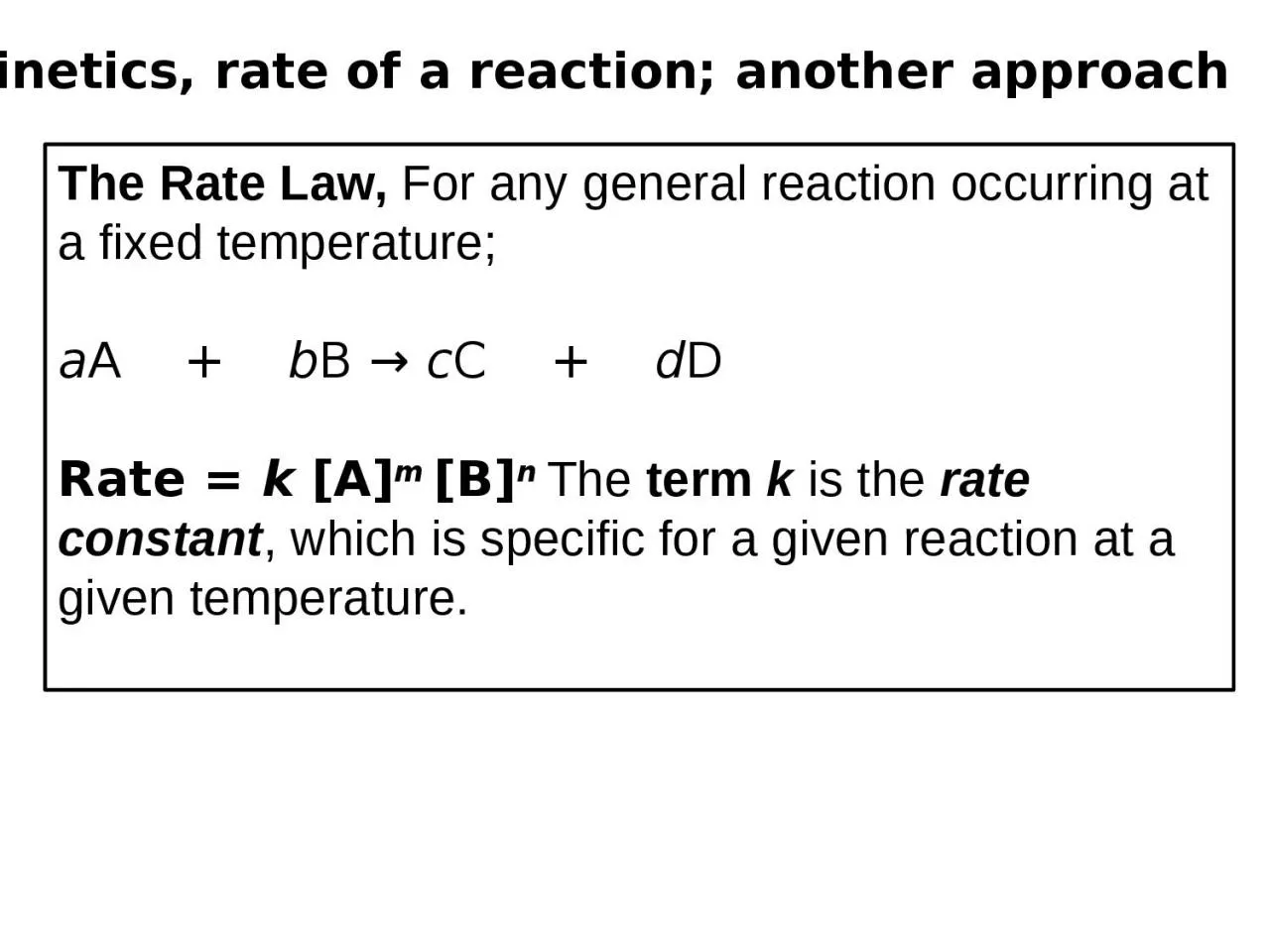

a A b B c C d D Rate k A m B n The term k is the rate constant which is specific for a given reaction at a given temperature ID: 1026550
Download Presentation The PPT/PDF document "The Rate Law, For any general reaction..." is the property of its rightful owner. Permission is granted to download and print the materials on this web site for personal, non-commercial use only, and to display it on your personal computer provided you do not modify the materials and that you retain all copyright notices contained in the materials. By downloading content from our website, you accept the terms of this agreement.
1. The Rate Law, For any general reaction occurring at a fixed temperature;aA + bB → cC + dDRate = k [A]m [B]n The term k is the rate constant, which is specific for a given reaction at a given temperature. Kinetics, rate of a reaction; another approach
2. Figure 16.5 Three types of reaction rates for the reaction of O3 and C2H4.
3. In general, for the reaction;aA + bB → cC + dD1aD[A]Dt1bD[B]Dtrate = –= – 1cD[C]Dt=1dD[D]Dt=where a, b, c, and d are the coefficients for the balanced equation, the rate is expressed as:The Rate Law for the following reactionFor any general reaction occurring at a fixed temperatureaA + bB → cC + dD ;Rate = k[A]m[B]nThe term k is the rate constant, which is specific for a given reaction at a given temperature.The exponents m and n are reaction orders and are determined by experiment.- The values of m and n are not necessarily related in any way to the coefficients a and b.
4. Reaction Orders; ratio between change in rate with change on reactant conc. or the simple reaction A → products:1. If the rate doubles when [A] doubles, the rate depends on [A]1 and the reaction is first order with respect to the ratio between the [A] and the rate at different conc of A’.2. If the rate quadruples when [A] doubles, the rate depends on [A]2 and the reaction is second order with respect to the ratio between [A] and the quadrupled rate at the increased conc of A. 3. If the rate does not change when [A] doubles, the rate does not depend on [A], and the reaction is zero order with respect to A, the rate depends on kt only.
5. Integrated Rate Laws, an integrated rate law includes time as a variable. The rxn order allows the choice of the right Rate Law equation. Rxn order can be determined by studying the rate vs change in reactant conc or plotting rate vs conc change, and determining the slope of the line to find the k value .First-order rate equation:rate = – [A]t= k [A]ln[A]0[A]t= ktSecond-order rate equation:rate = – [A]t= k [A]21[A]t1[A]0– = ktZero-order rate equation:rate = – [A]t= k [A]0[A]t – [A]0 = –kt
6. Graphical method for finding the reaction order from the integrated rate law.First-order reactionln[A]0[A]t= ktintegrated rate lawln[A]t = –kt + ln[A]0straight-line formA plot of ln [A] vs. time gives a straight line for a first-order reaction.
7. Graphical method for finding the reaction order from theintegrated rate law.Second-order reactionintegrated rate law1[A]t1[A]0– = ktstraight-line form1[A]t1[A]0= kt +A plot of vs. time gives a straight line for a second-order reaction. 1 [A]
8. Graphical method for finding the reaction order from the integrated rate law.Zero-order reactionA plot of [A] vs. time gives a straight line for a zero-order reaction.integrated rate law[A]t - [A]0 = –ktstraight-line form[A]t = –kt + [A]0
9. An Overview of Zero-Order, First-Order, and Simple Second-Order ReactionsZero OrderFirst OrderSecond OrderRate lawrate = krate = k[A]rate = k[A]2Units for kmol/L·s1/sL/mol·sHalf-lifeIntegrated rate law in straight-line form[A]t = -kt + [A]0ln[A]t = -kt + ln[A]0Plot for straight line[A]t vs. tln[A]t vs. t vs. tSlope, y intercept–k, [A]0–k, ln[A]0k, [A]02kln 2k1k[A]01[A]t= kt +1[A]01[A]t1[A]0
10. Figure 16.11Graphical determination of the reaction order for the decomposition of N2O5.The concentration data is used to construct three different plots. Since the plot of ln [N2O5] vs. time gives a straight line, the reaction is first order.
11. Units of the Rate Constant k for Several Overall Reaction OrdersOverall Reaction OrderUnits of k(t in seconds)0mol/L·s (or mol L-1s-1)11/s (or s-1)2L/mol·s (or L mol-1s-1)3L2/mol2·s (or L2 mol-2s-1)General formula: L order-1Units of k =The value of k is easily determined from experimental rate data. The units of k depend on the overall reaction order.unit of tmol
12.
13.
14. Calculating Activation Energyk = Ae–Ea/RTEa can be calculated from the Arrhenius equation:so ln k = ln A – Ea 1 R Tstraight-line formk2k1ln= – EaR– 1T11T2If data is available at two different temperatures:
15. Reaction energy diagrams and possible transition states for two reactions.
16. Reaction energy diagram for a catalyzed (green) and uncatalyzed (red) process.